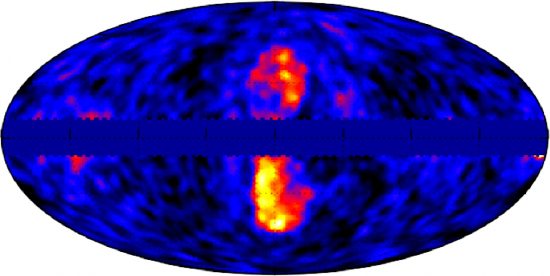
A map of >6.4 GeV emissions showing structures called, “Fermi bubbles” that appear connected to the center of the Galaxy. Credit: Fermi-LAT team, A. Franckowiak, D. Malyshev.
Jan 31, 2018
Gravity does not create gamma-rays.
Gamma-rays are thought by consensus physicists to be massless, yet possessed of extreme momentum. They are “electromagnetic particles” called photons. Since matter is thought to exist as both waves and particles, and photons are a class of particle called a “boson”, they “carry” the force of electromagnetism. Modern physics sees all forces as aspects of material phenomena: electromagnetism requires the photon; mass requires the Higgs boson; gravity requires the graviton and so forth,
Gamma-rays travel at enormous velocity (up to 2.993 x 10^10 centimeters per second), so “relativistic effects” are observed. Velocity is said to impart increased mass to the photons so they can have an impact on normal matter. When a relativistic electron strikes a low-energy (radio or infrared) photon, the collision slightly slows the electron and ramps up the photon to gamma-ray energy. Gamma-rays are, therefore, called, “ionizing radiation”, because they can knock electrons out of an atom.
Of the three types of natural radioactivity, gamma rays are the most energetic, with values 10^15 times greater than visible light. They also have short wavelengths, less than 0.1 nanometers, in some instances. Astrophysicists believe that electrons traveling near the speed of light power a gamma-ray source from the Milky Way’s core. Since virtually all galaxies, including the Milky Way, are thought to harbor supermassive black holes, NASA’s conclusion is that dark matter might be “torn apart” by intense gravity, creating exotic particles that, in turn, collide with normal, luminous matter, accelerating it to extreme velocities. However, the problem is not with the observation—the problem is with the interpretation.
NASA launched the Fermi Space Telescope (formerly known as GLAST) on June 11, 2008. Its primary mission is observing high frequency electromagnetic waves in space, including gamma-rays. It was Fermi that originally detected the intense gamma-ray emissions from the Milky Way.
Twin lobes of gamma-rays in the shape of an hourglass extend approximately 65,000 light-years out from each side of the Milky Way’s central bulge. However, rather than “bubbles” of radiation, the lobes are the signature of Birkeland currents squeezing plasma and charged dust into z-pinch zones. The intense electromagnetic fields associated with Birkeland current filaments cause electrons to accelerate with velocities close to light speed.
When charged particles, like electrons, accelerate through an electric field, they emit synchrotron radiation that often takes the form of X-rays and gamma-rays. Those high energies are not created in gravity fields. No near-infinite masses compressed into infinitesimal volumes are necessary. There are far more mundane factors that should be considered when analyzing data from space before resorting to super-dense objects and other exotic fictions.
Stephen Smith












